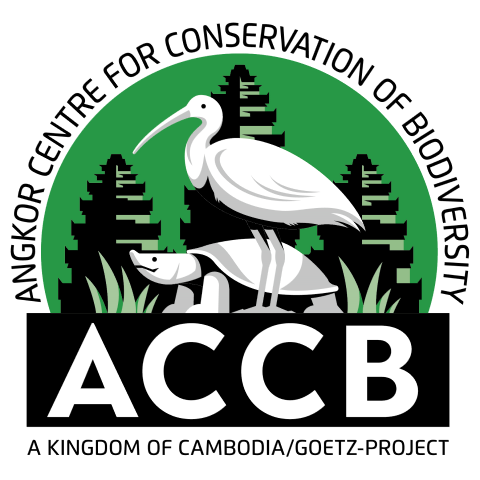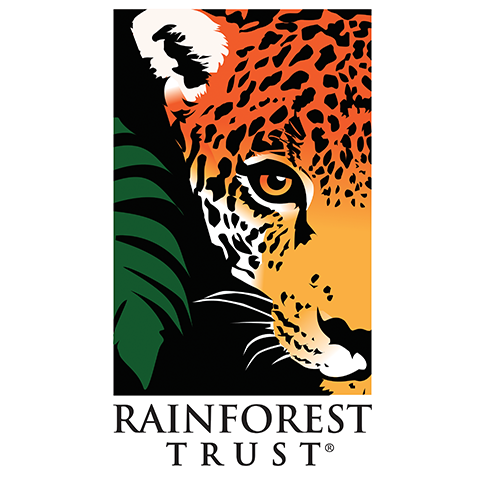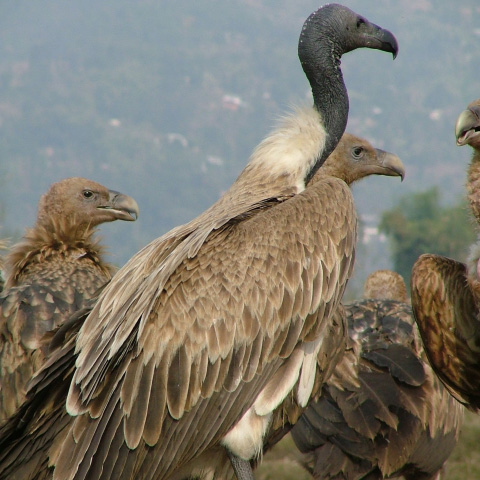Conservation Actions
Conservation Actions UnderwayCITES Appendix II, CMS Appendices I & II, Raptors MOU Category 1. It has been reported from many protected areas across its range. The governments of India, Nepal and Pakistan passed legislation in 2006 banning the veterinary use of diclofenac, and Bangladesh followed suit in 2010. A letter from the Drug Controller General of India in 2008 warned more than 70 drugs firms not to sell the veterinary form of diclofenac, and to mark human diclofenac containers 'not for veterinary use' (BirdLife International 2008). These bans have led to a reduction of diclofenac within ungulate carcasses (the principal food source for vultures) in India (Cuthbert et al. 2011a) and a study of 11 administrative districts in Nepal found diclofenac use dropped by 90% since 2006 following the introduction of measures to reduce its use (Anon 2008). However, levels of diclofenac contamination still remain high and human forms of the drug are still sold for veterinary use (Cuthbert et al. 2011a,b). In response to the misuse of human diclofenac, the Government of India banned the manufacture of all diclofenac products in vial sizes larger than 3 ml (the single dose for humans) in 2015, and this is predicted to make the drug too expensive and too complicated to use on large-bodied animals and thereby stop its misuse in livestock (T. Galligan in litt. 2016). Efforts to replace diclofenac with a suitable alternative are on-going and are showing signs of success with evidence for a decrease in diclofenac and an increase in the safe alternative (Cuthbert et al. 2011c ). An alternative drug, meloxicam, which is out of patent and manufactured in Asia has been tested on Gyps vultures with no ill-effects (Swan et al. 2006a, Swarup et al. 2007); though three additional drugs, aceclofenac, nimesulide and ketoprofen, are known to be toxic to vultures, and approximately another 10 drugs need to be tested (Galligan 2013, Cuthbert et al. 2016).
Searches for breeding sites in Nepal have proved successful, and these have been combined with outreach activities (Dhakal et al. 2014). Monitoring of vultures has been conducted in a number of protected areas in India, and monitoring of vulture populations combined with supplementary feeding is underway in the northern and eastern plains of Cambodia. There are currently seven vulture restaurants in Cambodia, which are run by The Cambodia Vulture Conservation Project, a partnership between the Royal Cambodian Government and national and international NGOs (e.g. Masphal and Vorsak 2007, H. Rainey in litt. 2008). Advocacy to reduce the use of poisons and poisoned bait to catch fish and waterfowl has succeeded in reducing the number of vultures being poisoned accidentally (S. Mahood in litt. 2012). A captive breeding and reintroduction scheme is underway in Thailand, run by the Department of National Parks Wildlife Plant Conservation, Zoological Park Organization, Kasetsart University and Seub Nakhasathien Foundation. There are currently 5 vultures at Nakhon Ratchasima Zoo and Huai Kha Khaeng Wildlife Breeding Research Station, and the first egg was laid in 2021 (Chaiyong 2021), but captive breeding efforts are not as advanced as they are for Critically Endangered Gyps vultures and these are urgently needed. Surveys utilising vulture restaurants were carried out in Myanmar in late 2006 and early 2007, accompanied by research into the locations of nesting colonies, causes of vulture deaths and potential that diclofenac was being used in livestock (Eames 2007).
SAVE (Saving Asia's Vultures from Extinction) has developed the concept of Vulture Safe Zones; areas (with a minimum of 100 km radius, equating to 30,000 km2) around important vulture breeding colonies, where education and advocacy efforts are focussed on eliminating the use of diclofenac and other vulture-toxic drugs, such as ketoprofen (Galligan 2013, Mukherjee et al. 2014). There are currently multiple Vulture Safe Zones being established in India, Nepal, Pakistan and Bangladesh (Mukherjee et al. 2014, DNPWC 2015, SAVE 2015).
The species is covered by a Multi-species Action Plan (MsAP) for the conservation of African-Eurasian vultures (Botha et al. 2017). An updated 5-year (2020-2025) action plan has been produced for vulture conservation in India (MoEFCC 2020), and a 4-year (2015-2019) action plan was was written for Nepal but has not been updated (DNPWC 2015). In 2012 the governments of India, Pakistan, Nepal and Bangladesh adopted a number of priority actions for the conservation of vultures, proposed by SAVE. These include banning large multi-dose vials of human diclofenac, testing other NSAIDs for toxicity to vultures and expanding the Vulture Safe Zones initiative (Galligan 2013).
Conservation Actions Proposed
Identify the location and number of remaining individuals and identify action required to prevent extinction. Measure the frequency of diclofenac treated carcasses available to vultures. Support the ban on the veterinary use of diclofenac and other vulture-toxic drugs, and support species management or restoration, as needed. Continue to carry out public awareness and public support programmes. Monitor remaining populations, in particular replicate conservation and research activities that have been implemented in Cambodia in Myanmar. Provide supplementary food sources, with appropriately-sized carcasses, where necessary for food-limited populations (see Hille et al. 2016). Support captive breeding efforts at a number of separate centres. Promote the immediate adoption of meloxicam as an alternatives to diclofenac. Test other NSAIDs to identify additional safe alternative drugs to diclofenac and also other toxic ones. Attempt to fully implement a restriction in the size of diclofenac vials sold for human use to make them less practical to use for veterinary purposes and take action against companies that fail to comply with the diclofenac ban (Cuthbert et al. 2011, SAVE 2014). Continue the operation of Vulture Safe Zones and expand the network of these sites (e.g. DNPWC 2015). A comprehensive list of conservation actions proposed can be found in Botha et al. (2017).
Location Information
Sarcogyps calvus occurs in Pakistan (previously regular, now a rare straggler with two in Tharparker in 2002 the first record since 1980 [Nadeem et al. 2007]), Nepal (still widespread, but has declined significantly such that it is virtually absent from most areas east of Kathmandu [Inskipp et al. 2016]), India (sparsely distributed and declining, now rare or absent from some areas, e.g. parts of Gujarat and the north-eastern states, but still fairly common in the west Himalayan foothills and reported in the Western Ghats between 2006 and 2010 [Ramesh et al. 2011]), Bangladesh (rare in the north-west), Bhutan, Myanmar (rare resident; recent records come mainly from Mount Victoria [Hla et al. 2011], with up to 11 in Shan state in 2003 - the first recent documented records in the east of the country [Bezuijen et al. 2010]), China (unrecorded in Yunnan since the late 1960s [S. Chan in litt. 2006]; possibly occurs in south-east Tibet), Thailand (near extinct or possibly now extinct in the country [P. Round in litt. 2006, S. Mahood in litt. 2016]), Laos (previously widespread and common, but now only occasional wanderers from the Cambodian population), Viet Nam (previously regular in central regions, but now only occasional wanderers from the Cambodian population), Cambodia (previously common, now rare and restricted to the northern and eastern plains; with a minimum of only 47 individuals in 2010 [Clements et al. 2013]), peninsular Malaysia (previously locally common in north, now absent), and Singapore (formerly occurred, apparently now absent) (Ferguson-Lees et al. 2001).Historical reports indicate that it was widespread and generally abundant, but it has undergone a massive population and range decline in recent decades. Recent information indicates that in India the species started undergoing a rapid decline (41% per year) in about 1999, and declined by 91% between the early 1990s and 2003 (Cuthbert et al. 2006). Declines in the Indian Subcontinent have followed widely reported and well-researched declines in Gyps vultures owing to mortality following ingestion of the non-steroidal anti-inflammatory drug (NSAID) diclofenac, used to treat livestock, and it is hypothesised that this same drug has been responsible for the observed trends in Red-headed Vulture in the region. Given the lack of intensive agriculture and associated chemical use in South-East Asia, and the continued presence of large areas of suitable habitat for the species, the main reasons behind its decline in this region are thought to be accidental poisoning (through hunting), the demise of large ungulate populations and improvements in animal husbandry resulting in a lack of available carcasses for vultures (Clements et al. 2013). Given its rarity in South-East Asia, it is unlikely that more than a few hundred individuals remain there, while the total population seems unlikely to exceed 10,000 mature individuals given the patchiness of its distribution across India and the apparently catastrophic very recent declines.
Geographic Range
Extant
Bangladesh, Bhutan, Cambodia, China, India, Lao People's Democratic Republic, Myanmar, Nepal, Pakistan, Viet Nam
Possibly Extinct
Malaysia, Thailand
Population Information
Given its rarity in South-East Asia it is unlikely that more than a few hundred individuals remain there, while the total population seems unlikely to exceed 10,000 mature individuals given the patchiness of its distribution across India and the apparently catastrophic very recent declines. In light of this it is placed in the band 2,500-9,999 mature individuals. This roughly equates to 3,750-14,999 individuals in total, here rounded to 3,500-15,000 individuals.Threats
The disappearance of vultures from Asia is linked to a suite of factors: notably the demise of wild ungulates, unintentional poisoning, the intensification of agriculture, increased sophistication of waste disposal techniques, direct persecution and disease (Clements et al. 2013). However, rapid declines since the turn of the 21st century are believed to have been driven by the pharmaceutical NSAID diclofenac used to treat livestock, which has proven highly toxic to Gyps vultures, causing mortality from renal failure that results in visceral gout (Cuthbert et al. 2006). A recent study found that Red-headed Vulture population declines in India had slowed and were possibly increasing following a ban on diclofenac, which suggests that the species is also adversely affected by the drug (Galligan et al. 2014). It seems plausible that this species previously had less exposure to the toxin owing to competitive exclusion from carcasses by Gyps spp. vultures (Cuthbert et al. 2006). Surveys in Myanmar in late 2006 and early 2007 found no evidence that diclofenac was being used in livestock (Eames 2007) and it is not in use in Cambodia (Mahood in litt. 2012). A range of other NSAIDs (aclofenac [a pro-drug of diclofenac], ketoprofen, nimesulide and flunixin) have also now been found to be toxic to vultures (Naidoo et al. 2010, Zorrilla et al. 2015, Cuthbert et al. 2016, Galligan et al. 2016). In Cambodia at least it experiences some incidental mortality through the widespread use of poisons to catch fish or waterbirds at trapeangs (waterholes) (Clements et al. 2013). Intentional poisoning for belief-based use has also been reported in Cambodia (Botha et al. 2017). The logging of nesting trees may also be a potential threat (D. Bohra in litt. 2016), as may electrocution and collision with powerlines (Botha et al. 2017).Partners
IUCN Red List Account Link
Please click here to see the species' IUCN Red List Account page.Photo Credits
OV Gjershaug (category image)
Roland Wirth (featured image)









